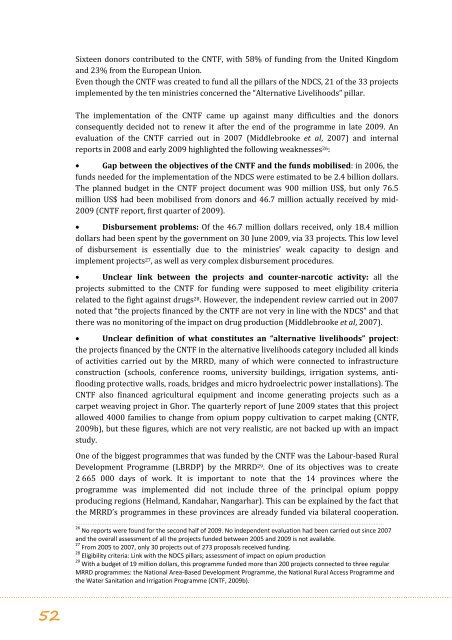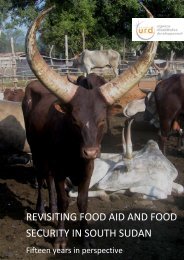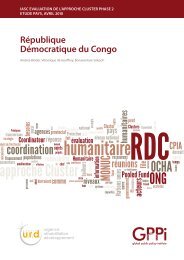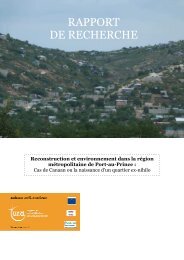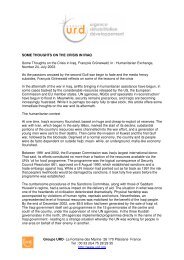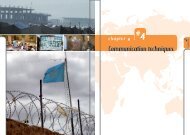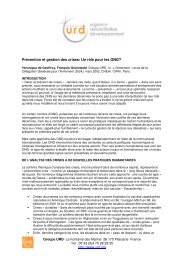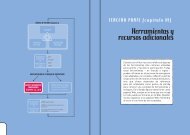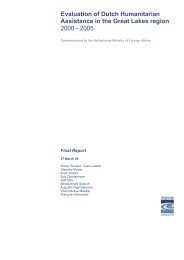strategies to counter opiate in Afghanistan - Groupe URD
strategies to counter opiate in Afghanistan - Groupe URD
strategies to counter opiate in Afghanistan - Groupe URD
You also want an ePaper? Increase the reach of your titles
YUMPU automatically turns print PDFs into web optimized ePapers that Google loves.
Sixteen donors contributed <strong>to</strong> the CNTF, with 58% of fund<strong>in</strong>g from the United K<strong>in</strong>gdom<br />
and 23% from the European Union.<br />
Even though the CNTF was created <strong>to</strong> fund all the pillars of the NDCS, 21 of the 33 projects<br />
implemented by the ten m<strong>in</strong>istries concerned the “Alternative Livelihoods” pillar.<br />
The implementation of the CNTF came up aga<strong>in</strong>st many difficulties and the donors<br />
consequently decided not <strong>to</strong> renew it after the end of the programme <strong>in</strong> late 2009. An<br />
evaluation of the CNTF carried out <strong>in</strong> 2007 (Middlebrooke et al, 2007) and <strong>in</strong>ternal<br />
reports <strong>in</strong> 2008 and early 2009 highlighted the follow<strong>in</strong>g weaknesses 26 :<br />
• Gap between the objectives of the CNTF and the funds mobilised: <strong>in</strong> 2006, the<br />
funds needed for the implementation of the NDCS were estimated <strong>to</strong> be 2.4 billion dollars.<br />
The planned budget <strong>in</strong> the CNTF project document was 900 million US$, but only 76.5<br />
million US$ had been mobilised from donors and 46.7 million actually received by mid-<br />
2009 (CNTF report, first quarter of 2009).<br />
• Disbursement problems: Of the 46.7 million dollars received, only 18.4 million<br />
dollars had been spent by the government on 30 June 2009, via 33 projects. This low level<br />
of disbursement is essentially due <strong>to</strong> the m<strong>in</strong>istries’ weak capacity <strong>to</strong> design and<br />
implement projects 27 , as well as very complex disbursement procedures.<br />
• Unclear l<strong>in</strong>k between the projects and <strong>counter</strong>-narcotic activity: all the<br />
projects submitted <strong>to</strong> the CNTF for fund<strong>in</strong>g were supposed <strong>to</strong> meet eligibility criteria<br />
related <strong>to</strong> the fight aga<strong>in</strong>st drugs 28 . However, the <strong>in</strong>dependent review carried out <strong>in</strong> 2007<br />
noted that “the projects f<strong>in</strong>anced by the CNTF are not very <strong>in</strong> l<strong>in</strong>e with the NDCS” and that<br />
there was no moni<strong>to</strong>r<strong>in</strong>g of the impact on drug production (Middlebrooke et al, 2007).<br />
• Unclear def<strong>in</strong>ition of what constitutes an “alternative livelihoods” project:<br />
the projects f<strong>in</strong>anced by the CNTF <strong>in</strong> the alternative livelihoods category <strong>in</strong>cluded all k<strong>in</strong>ds<br />
of activities carried out by the MRRD, many of which were connected <strong>to</strong> <strong>in</strong>frastructure<br />
construction (schools, conference rooms, university build<strong>in</strong>gs, irrigation systems, antiflood<strong>in</strong>g<br />
protective walls, roads, bridges and micro hydroelectric power <strong>in</strong>stallations). The<br />
CNTF also f<strong>in</strong>anced agricultural equipment and <strong>in</strong>come generat<strong>in</strong>g projects such as a<br />
carpet weav<strong>in</strong>g project <strong>in</strong> Ghor. The quarterly report of June 2009 states that this project<br />
allowed 4000 families <strong>to</strong> change from opium poppy cultivation <strong>to</strong> carpet mak<strong>in</strong>g (CNTF,<br />
2009b), but these figures, which are not very realistic, are not backed up with an impact<br />
study.<br />
One of the biggest programmes that was funded by the CNTF was the Labour-based Rural<br />
Development Programme (LBRDP) by the MRRD 29 . One of its objectives was <strong>to</strong> create<br />
2 665 000 days of work. It is important <strong>to</strong> note that the 14 prov<strong>in</strong>ces where the<br />
programme was implemented did not <strong>in</strong>clude three of the pr<strong>in</strong>cipal opium poppy<br />
produc<strong>in</strong>g regions (Helmand, Kandahar, Nangarhar). This can be expla<strong>in</strong>ed by the fact that<br />
the MRRD’s programmes <strong>in</strong> these prov<strong>in</strong>ces are already funded via bilateral cooperation.<br />
………………………………………………………………………………………………………………………………………………………………<br />
26 No reports were found for the second half of 2009. No <strong>in</strong>dependent evaluation had been carried out s<strong>in</strong>ce 2007<br />
and the overall assessment of all the projects funded between 2005 and 2009 is not available.<br />
27 From 2005 <strong>to</strong> 2007, only 30 projects out of 273 proposals received fund<strong>in</strong>g.<br />
28 Eligibility criteria: L<strong>in</strong>k with the NDCS pillars; assessment of impact on opium production<br />
29 With a budget of 19 million dollars, this programme funded more than 200 projects connected <strong>to</strong> three regular<br />
MRRD programmes: the National Area-Based Development Programme, the National Rural Access Programme and<br />
the Water Sanitation and Irrigation Programme (CNTF, 2009b).<br />
52


